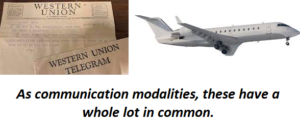Air Service Access Planning:
A Message From Western Union.
We’re talking about telegrams. It was once the fastest way of communication over long distances. Used as late as the 1960s, too.
But there was a process. You had to go to a Western Union office, fill out some forms, write out the message, give it to a clerk. The clerk then manually typed it into a machine about as big as a player piano. The message was routed via wires to another WU office, where it came up on another player piano, line by line, going “chunka chunka.” Then the messag was put onto another form, inserted into an envelope and was hand delivered to the addressee.
Several hours. But it was way faster than other hard-data communication channels.
Try to send a telegram today. Smoke signals would work just as well.
 The message for air service development is that air travel – like telegrams – is a communication modality. And, the value of these modalities evolve relative to new disruptive ones.
The message for air service development is that air travel – like telegrams – is a communication modality. And, the value of these modalities evolve relative to new disruptive ones.
Telegrams have long since been eclipsed by other channels. It is the same with certain applications of air transportation, particularly in the business travel sector.
Until the 1990s, the fastest way to communicate information and data, as well as accomplish personal interaction between, say, Boston and Islip or Austin and El Paso, or Sacramento and Miami etc., was by physically moving them, give or take some fax options. At one time, getting documents and important papers rapidly between cities like these was by using air transportation.
Plus, the only way to have one-on-one personal contact was by using air travel. Need a two hour meeting with the marketing department? Start planning your trip, getting reservations, ground arrangements, and related. Today, in many instances it’s a 20-second log on process for Zoom or Skype or Teams.
It doesn’t take much imagination to conclude that a lot of air transportation has been rendered unnecessary and, indeed, time-inefficient by the emergence of electronic communication channels. Even things like legal depositions are now accomplished by electronic means.
Some ASD Programs Are The Equivalent of Stringing New Telegraph Wire. Not to beat a dead teletype machine, but it is incredible how much time and energy and money are tossed at jive programs futilely trying to bring back air service that in many cases has been leapfrogged as a communication channel, every bit as much as have telegrams.
It is astounding how many media stories are written each month, implying how some small communities are now “cut off” by not having scheduled flights at the local airport, without any understanding of fundamental changes in communication systems in the last 15 years. The inescapable fact is that, like telegrams, some forms of air travel simply are not cost-competitive nor time-competitive any longer. It is also an inescapable fact that the entire fleets that made such travel economically-viable are rapidly disappearing.
ASD Needs To Be Only One Component of Regional Communication Systems Planning. Here’s the next wave in rural economic development: communication planning. This encompasses how connected a region is, encompassing all channels. It also demands a professional understanding of the economics of air transportation as they affect the region. It requires an honest determination of the real potential access to connective air service, and how to accept and address it, within honest realities.
As we’ve noted repeatedly in the past year, the doors are opening for new economic recruitment for small and rural communities and their local airports. There are regions of the USA where dimbulb regulations are causing small and mid-size businesses to consider re-location. Or, maybe better described, looking to escape.
Communication is evolving. In the process, it is shifting how air travel fits in. Or doesn’t.
Heresy, of course. But true.
__________
A Reminder
Raw numbers from government sources are not reliable. There are lots of areas where DOT data is derived based on past aviation structure.
 This is the reason Boyd Group International relies on Cirium for aviation data and related insight.
This is the reason Boyd Group International relies on Cirium for aviation data and related insight.
The industry is changing. Air transportation is changing. Understanding past data and trends is critical understanding these shifts. This requires accurate data. Check out Cirium.
______________